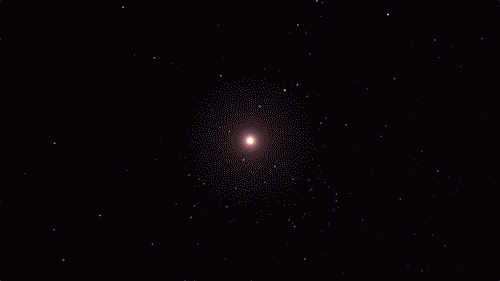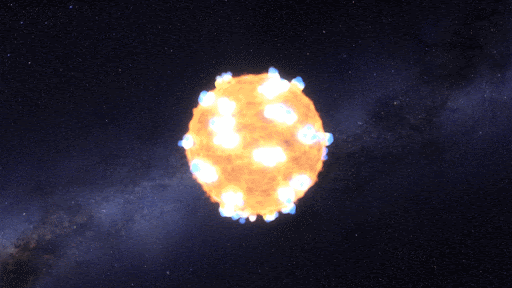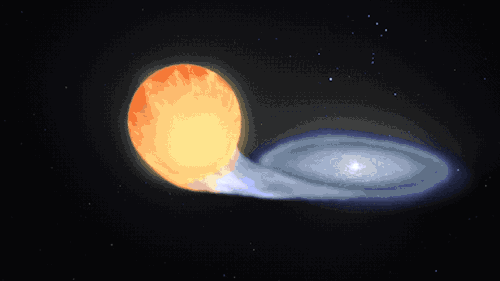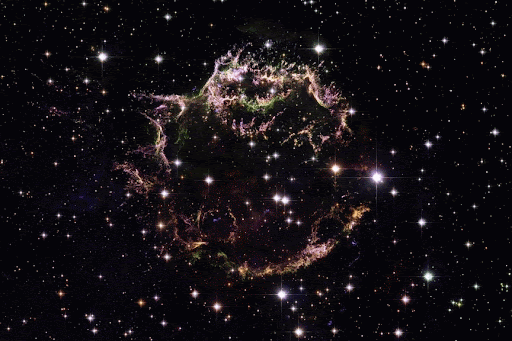Cosmic Debris.

Cosmic Debris.
You can get this GIF as a phone wallpaper for free through the Zedge app.
You can also get this GIF as a looping 1080p video if you support me on Patreon.
Twitter / Instagram / Shop / Gumroad / Patreon / Zedge
More Posts from Epic-flight and Others
The amazing final seconds of yesterday’s Starship landing. @spacex https://www.instagram.com/p/CInrXfSniww/?igshid=1b5o8ndalzcq9
You Are Made of Stardust
Though the billions of people on Earth may come from different areas, we share a common heritage: we are all made of stardust! From the carbon in our DNA to the calcium in our bones, nearly all of the elements in our bodies were forged in the fiery hearts and death throes of stars.

The building blocks for humans, and even our planet, wouldn’t exist if it weren’t for stars. If we could rewind the universe back almost to the very beginning, we would just see a sea of hydrogen, helium, and a tiny bit of lithium.
The first generation of stars formed from this material. There’s so much heat and pressure in a star’s core that they can fuse atoms together, forming new elements. Our DNA is made up of carbon, hydrogen, oxygen, nitrogen, and phosphorus. All those elements (except hydrogen, which has existed since shortly after the big bang) are made by stars and released into the cosmos when the stars die.

Each star comes with a limited fuel supply. When a medium-mass star runs out of fuel, it will swell up and shrug off its outer layers. Only a small, hot core called a white dwarf is left behind. The star’s cast-off debris includes elements like carbon and nitrogen. It expands out into the cosmos, possibly destined to be recycled into later generations of stars and planets. New life may be born from the ashes of stars.

Massive stars are doomed to a more violent fate. For most of their lives, stars are balanced between the outward pressure created by nuclear fusion and the inward pull of gravity. When a massive star runs out of fuel and its nuclear processes die down, it completely throws the star out of balance. The result? An explosion!
Supernova explosions create such intense conditions that even more elements can form. The oxygen we breathe and essential minerals like magnesium and potassium are flung into space by these supernovas.

Supernovas can also occur another way in binary, or double-star, systems. When a white dwarf steals material from its companion, it can throw everything off balance too and lead to another kind of cataclysmic supernova. Our Nancy Grace Roman Space Telescope will study these stellar explosions to figure out what’s speeding up the universe’s expansion.
This kind of explosion creates calcium – the mineral we need most in our bodies – and trace minerals that we only need a little of, like zinc and manganese. It also produces iron, which is found in our blood and also makes up the bulk of our planet’s mass!

A supernova will either leave behind a black hole or a neutron star – the superdense core of an exploded star. When two neutron stars collide, it showers the cosmos in elements like silver, gold, iodine, uranium, and plutonium.

Some elements only come from stars indirectly. Cosmic rays are nuclei (the central parts of atoms) that have been boosted to high speed by the most energetic events in the universe. When they collide with atoms, the impact can break them apart, forming simpler elements. That’s how we get boron and beryllium – from breaking star-made atoms into smaller ones.
Half a dozen other elements are created by radioactive decay. Some elements are radioactive, which means their nuclei are unstable. They naturally break down to form simpler elements by emitting radiation and particles. That’s how we get elements like radium. The rest are made by humans in labs by slamming atoms of lighter elements together at super high speeds to form heavier ones. We can fuse together elements made by stars to create exotic, short-lived elements like seaborgium and einsteinium.

From some of the most cataclysmic events in the cosmos comes all of the beauty we see here on Earth. Life, and even our planet, wouldn’t have formed without them! But we still have lots of questions about these stellar factories.
In 2006, our Stardust spacecraft returned to Earth containing tiny particles of interstellar dust that originated in distant stars, light-years away – the first star dust to ever be collected from space and returned for study. You can help us identify and study the composition of these tiny, elusive particles through our Stardust@Home Citizen Science project.
Our upcoming Roman Space Telescope will help us learn more about how elements were created and distributed throughout galaxies, all while exploring many other cosmic questions. Learn more about the exciting science this mission will investigate on Twitter and Facebook.
Make sure to follow us on Tumblr for your regular dose of space!

HiPOD 18 Jan 2022: Icy Cliffs on Mars
This area, on the western edge of Milankovic Crater on Mars, has a thick deposit of sediment that covers a layer rich in ice. The ice is not obvious unless you look in color.
In the red-green-blue images that are close to what the human eye would see, the ice looks bright white, while the surroundings are a rusty red. The ice stands out even more clearly in the infrared-red-blue images where it has a striking bluish-purple tone while the surroundings have a yellowish-grey color.
The ice-rich material is most visible when the cliff is oriented east-west and is shielded from the sun as it arcs through the sky to the south.
Enhanced color image is less than 1 km across.
ID: ESP_071573_2350 date: 2 November 2021 altitude: 307 km
NASA/JPL/UArizona

Me irl

Lynds Dark Nebula 1251 : Stars are forming in Lynds Dark Nebula (LDN) 1251. About 1,000 light-years away and drifting above the plane of our Milky Way galaxy, the dusty molecular cloud is part of a complex of dark nebulae mapped toward the Cepheus flare region. Across the spectrum, astronomical explorations of the obscuring interstellar clouds reveal energetic shocks and outflows associated with newborn stars, including the telltale reddish glow from scattered Herbig-Haro objects seen in this sharp image. Distant background galaxies also lurk on the scene, buried behind the dusty expanse. This alluring view imaged with a backyard telescope and broadband filters spans about two full moons on the sky, or 17 light-years at the estimated distance of LDN 1251. via NASA

Another oldie from my draft folder. I’d like to do a mass deletion of 99% of my unposted drafts.

Flash Forward.
Twitter / Instagram / Gumroad / Patreon
KnownOrigin / SuperRare / Zedge

Pink Sparkles.
Twitter / Instagram / Gumroad / Patreon
KnownOrigin / SuperRare / OBJKT / Zedge

Welcome planet Mercury in a 1970 illustration by David A. Hardy for Vision of Tomorrow. (AstroArt)
-
 laclochard liked this · 2 years ago
laclochard liked this · 2 years ago -
 halfpoisonhalfgod liked this · 3 years ago
halfpoisonhalfgod liked this · 3 years ago -
 sparkle-mermaid-princess reblogged this · 3 years ago
sparkle-mermaid-princess reblogged this · 3 years ago -
 thoughtsofanabstractmind reblogged this · 3 years ago
thoughtsofanabstractmind reblogged this · 3 years ago -
 planetdogor liked this · 3 years ago
planetdogor liked this · 3 years ago -
 blossomjazz7 reblogged this · 3 years ago
blossomjazz7 reblogged this · 3 years ago -
 vulnerableparts reblogged this · 3 years ago
vulnerableparts reblogged this · 3 years ago -
 stonerparty reblogged this · 3 years ago
stonerparty reblogged this · 3 years ago -
 steliosagapitos reblogged this · 3 years ago
steliosagapitos reblogged this · 3 years ago -
 steliosagapitos liked this · 3 years ago
steliosagapitos liked this · 3 years ago -
 roundabouttotheedge reblogged this · 3 years ago
roundabouttotheedge reblogged this · 3 years ago -
 miaaccountforpersonal liked this · 3 years ago
miaaccountforpersonal liked this · 3 years ago -
 eliseo-93 liked this · 3 years ago
eliseo-93 liked this · 3 years ago -
 shadowedseas reblogged this · 3 years ago
shadowedseas reblogged this · 3 years ago -
 nospheratusblack liked this · 3 years ago
nospheratusblack liked this · 3 years ago -
 ncvabcrn-archive reblogged this · 3 years ago
ncvabcrn-archive reblogged this · 3 years ago -
 2places1time reblogged this · 4 years ago
2places1time reblogged this · 4 years ago -
 2places1time liked this · 4 years ago
2places1time liked this · 4 years ago -
 movingworld reblogged this · 4 years ago
movingworld reblogged this · 4 years ago -
 kaostography liked this · 4 years ago
kaostography liked this · 4 years ago -
 m00ndingochan reblogged this · 4 years ago
m00ndingochan reblogged this · 4 years ago -
 m00ndingochan liked this · 4 years ago
m00ndingochan liked this · 4 years ago -
 fivefifteen reblogged this · 4 years ago
fivefifteen reblogged this · 4 years ago -
 goldfox95 liked this · 4 years ago
goldfox95 liked this · 4 years ago -
 proximio-5 liked this · 4 years ago
proximio-5 liked this · 4 years ago -
 andarky liked this · 4 years ago
andarky liked this · 4 years ago -
 meanya liked this · 4 years ago
meanya liked this · 4 years ago -
 themystic50 liked this · 4 years ago
themystic50 liked this · 4 years ago -
 derbyshiredragon liked this · 4 years ago
derbyshiredragon liked this · 4 years ago -
 all-in-all-is-all-we-r liked this · 4 years ago
all-in-all-is-all-we-r liked this · 4 years ago -
 xlonexwolfx liked this · 4 years ago
xlonexwolfx liked this · 4 years ago -
 neotoymaker reblogged this · 4 years ago
neotoymaker reblogged this · 4 years ago -
 neotoymaker liked this · 4 years ago
neotoymaker liked this · 4 years ago -
 imfbsl liked this · 4 years ago
imfbsl liked this · 4 years ago -
 mysticalmeditation liked this · 4 years ago
mysticalmeditation liked this · 4 years ago -
 io-robirobot liked this · 4 years ago
io-robirobot liked this · 4 years ago

